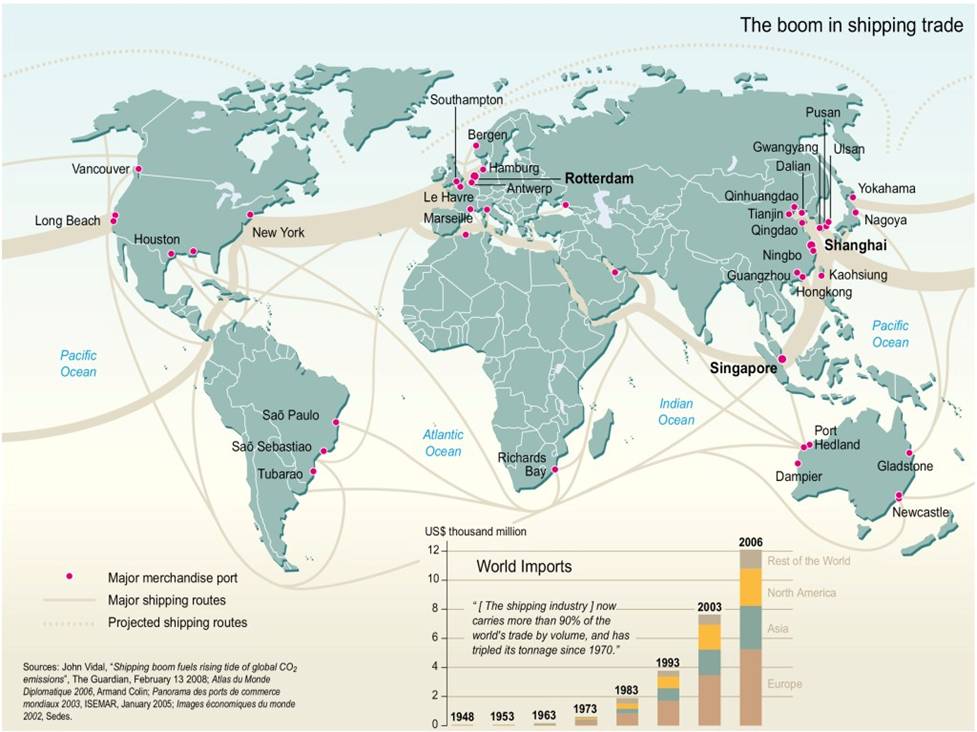Trade 2.0
As already stated in 2008 the world trade was at its peak in 2008, as was maritime trade. The discovery of “the box”, ie. the container, changed the world in facilitating separate (bulk) goods being transferred on large container ships from one end of the world to the other. Over the years an efficient hub spoke system was established. The world shipping trade map looked as follows:
The bursting of the capitalism bubble in the fall of 2008 marked a turning point for the maritime trade. Many people concluded that the capitalist banking system was overhyped, when in fact a huge economic decline was expected anyway also based on the dependency of the dollar and the state deficit in the US. International power shifts, and thus currency leadership, typically mark the point at which other ascendant countries are ready to take their respective places at center stage. The burst was enormous, but economic recovery came fast. Economic recovery, however, was selective and left Western Europe and the USA behind. ‘Behind’ meaning that in growth was not as steep as in Asia and Brazil, where recovery came first.
Copenhagen is a big success. World leaders, motivated by the first signs of recovery, but bearing in mind the burst and realizing we should treat the globe better, agree on a world changing treaty. 18 December 2009 history is made, sustainable is the buzz word. Countries are bound to tighten CO2 emission rules, including an efficient 'carrot and stick' system. The treaty marks the take off of “Trade 2.0” as a means to a greener way of producing and trading. The world trade map as depicted above changes.
The concept of "Trade 2.0" further developed with a conference brainstorming session between Western African countries and the BRIC countries on trade in 2011. Pioneer and engineer Mr Baghia from Kushal, initiated the meeting, revealing that Kushal expected the oil fields in Kazakhstan higher than ever expected. Also Baghia unfolded a concept for an effective way for Brazil and China to meet the requirements of Copenhagen 2009. China and Brazil would exploit African’s (mineral) resources while making the AFrican people truly benefit from that - establishing joint ventures where production would be done, where most logical given the environmental consequences. The plans were highly secretive and nobody got to speak about the “Trade 2.0” for ABRICA (a combination of Africa and BRIC) concept. In 2012 a republican president is elected in the US and the majority of the European countries are being governed by nationalist right wing politicians. The European Union is both gaining influence from a Europe against the rest of the world perspective, while the new nationalist movements want to diminish the influence of Brussels. In 2012, Europe and the US began to realize that something was going on and they were left out. Emphasis was on observing the Stockholm treaty. Meanwhile, nationalist parties were most effective in marketing the sustainability buzz word, stretching it to the concept that home grown and produced goods are better than imported goods. The ports in Europe and America loose trade and can no longer make major investments. Maritime trade routes are shifting towards the ABRICA region, as well as within Europe. The United States are developing inland train by government grants to high speed transportation train lines and bulk plane carriers. The latter causes great concern with the observation of the Stockholm treaty. In 2012 Braghia announces the discovery of the new oil fields in Kazakhstan. Also in 2012, Northern America and Europe are facing losses at the olympic level again. While Brazil is preparing for the World Cup in 2014 and the Olympics in 2016, Nagasaki and Hiroshima will host the Olympics in 2020. Buy 2012 European and American ports have halved in size, focussing more and more and a smaller spoke spoke system
Meanwhile, in 2015 Europe closes its borders to international trade to a large extent, while exciting new trade and joint ventures are popping up regarding ABRICA. What's more, the companies that combine the best of all worlds seemed to have some things in common. Trade 2.0 is a success. Ports in western Africa are growing, while Shanghai maintains it’s position of being largest and being best in all capacities. Sao Paulo is flourishing beside a port just next to Rio, that is a true Olympic effort. In 2020, the term "Trade 2.0" has clearly taken hold, with more than 15 million citations in Google. Trade 2.0 represents fair growth in Africa, and its ports, together with countries that were named developing countries themselves not so long ago. Trade 2.o represents a sustainable means of producing, co-operating and transportation. Despite all green efforts by both the inward looking Western countries and the ABRICA countries, by 2020 it is expected that the Northern route will soon be a trading route due to the melting of the ice cap, enabling Europe to take a position again. The future remains to be seen...
